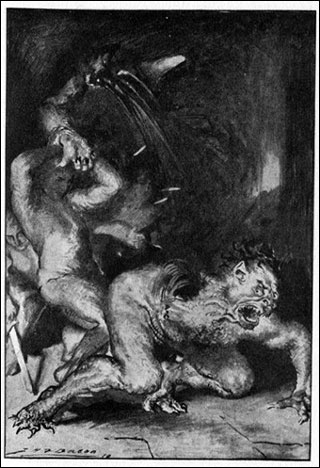
Beowulf tears the arm and shoulder off Grendel by John Henry Frederick Bacon. (Illustration is in the public domain. Ebbutt, M. I. "The British. Myths and Legends." G. G. Harrap and Company. 1910.)
Instructor(s)
Arthur Bahr
MIT Course Number
21L.705
As Taught In
Spring 2014
Level
Undergraduate
Course Description
Course Features
- Subtitles/transcript
- Demonstration - video
- Exams and solutions
- Instructor insights
- This Course at MIT
Course Description
hƿæt ƿe gardena in geardagum þeodcyninga þrym gefrunon hu ða æþelingas ellen fremedon…. Those are the first words of the Old English epic Beowulf, and in this class you will learn to read them.
Besides being the language of Rohan in the novels of Tolkien, Old English (also called Anglo-Saxon) is a language of long, cold, and lonely winters; of haunting beauty found in unexpected places; and of unshakable resolve in the face of insurmountable odds.
It is, in short, the perfect language for MIT students.
After learning the basics of grammar and vocabulary, we will read not just excerpts from the great Beowulf but also heartrending laments (The Wanderer, The Wife's Lament), an account of the Crucifixion as narrated by the Cross itself (The Dream of the Rood), and a host of riddles whose solutions range from the sacred to the obscene but are always ingenious. We will also try our hand at composing our own sentences—and maybe even poems—in Old English.
Other Versions
Other OCW Versions
OCW has published multiple versions of this subject. ![]()
- 21L.705 Major Authors: America's Literary Scientists (Fall 2010)
- 21L.705 Major Authors: Rewriting Genesis: "Paradise Lost" and Twentieth-Century Fantasy (Spring 2009)
- 21L.705 Major Authors: John Milton (Spring 2008)
- 21L.705 Major Authors: After the Masterpiece: Novels by Melville, Twain, Faulkner, and Morrison (Fall 2006)
- 21L.705 Masterworks in American Short Fiction (Fall 2005)
- 21L.705 Major Authors: Melville and Morrison (Fall 2003)
- 21L.705 Major Authors: Oscar Wilde and the '90's (Spring 2003)


